For a lot of small businesses, the challenge of building and maintaining an active community on Facebook is scary enough on its own.
Combine that with some of the recent stories about the death of organic reach, and the tales of a mysterious News Feed algorithm, and you might have nightmares too.
But before you crawl under your covers or go to sleep with the lights on, here’s some good news:
Building an engaged community on Facebook doesn’t have to be a horror story. Even with the decline in organic reach, with the right plan, you can get your business to show up on Facebook and avoid turning into a ghost.
Here are 7 common mistakes you’ll need to avoid:
1. Not thinking about your audience
While it’s easy to get upset about changes on Facebook, it’s important to remember that Facebook’s goal is to provide the best possible experience for the people using its site. That means making it as easy as possible for people to connect with the audience and brands that matter to them, and offering users content they will find interesting.
As a business, the best way to stay alive on Facebook is to stay focused on the audience you’re trying to reach.
The last thing you want is to come off like a brainless zombie, feeding off your fans without offering something of value.
Think about your ideal customer. What type of content would they find interesting? How can you create an experience that will make them want to come back and tell their friends about you?
2. Ignoring your Insights
A lot of businesses still treat Facebook Insights like the haunted house in the neighborhood that no one dares to enter.
While this tool can be a little intimidating at first, it’s filled with a ton of helpful information to help improve your Facebook strategy.
You can see what’s working, what’s not, and what you could be doing differently to improve your results.
It will also help you learn more about the people who Like your page, and make smarter decisions about when to post for maximum reach and engagement.
3. Not listening to feedback
In addition to likes, comments, and shares — which your audience can use to tell you what they like seeing on Facebook — your fans can also use negative feedback to tell you what they don’t like.
Negative feedback is when fans hide your posts or report them as spam within the news feed. This is Facebook’s way of helping users ward off shadowy creatures and keep their feed safe.
This negative feedback indicates to Facebook that a fan isn’t interested in the content you are sharing, which is guaranteed to make your posts disappear.
Learn more: How Facebook Decides if Your Posts Are Naughty or Nice
4. Not sticking with it
You’ve probably heard the stories of ghosts and goblins that only come out on Halloween.
Unlike those creatures, you need to make sure you’re showing up on a consistent basis if you want to build an engaged audience on Facebook.
If you’re only haunting your fans when you have something to promote, you could hurt your engagement and limit your reach in the process.
Learn more: Show Up in the Facebook News Feed! 8 Things that Really Work
5. Posting too often
Imagine if every trick-or-treater tried knocking on your door six times throughout the night. Even if they showed up wearing a different costume each time, eventually you’d cut them off.
The same is true when it comes to your Facebook Page. If you’re posting too frequently, fans can start to get annoyed. This can result in more negative feedback, but can also cause fans to tune you out.
To keep you from disturbing your fans, Facebook will start to limit your reach. After that, it won’t matter how much you post, no one will see your posts (or hear your screams)!
Learn more: 13 Terrifying Facebook Mistakes That Can Scare Your Fans Away
6. Not mixing it up
With so much to be afraid of, you might feel like your best option is to just play it safe.
For a lot of businesses, that means sticking to one type of Facebook post and putting your posting strategy on autopilot.
But beyond the danger of boring fans to death, if you’re not experimenting with different kinds of posts you could be making it difficult to get your content seen.
A successful posting schedule should include a mix of text, photos, videos, and links. Some of these posts will be better for reach, on Facebook; others will be better for engagement (likes, comments, and shares).
Learn more: Tips for Creating Better Facebook Content
7. Running away from Facebook Ads
When it comes to paying to promote on Facebook, many business owners think they need to run for their lives. After all, you probably signed up for Facebook expecting it to be a completely free platform.
But while you may have been reluctant to promote your content in the past, you shouldn’t treat Facebook Ads like a monster under your bed.
Facebook has built a powerful ad platform to help businesses extend their reach and target potential customers. You can target based on location, demographics, and even past purchasing behavior, and then choose to promote your content to existing fans, or reach an entirely new audience.
Facebook has worked hard to make ads accessible to small businesses. Start small and see what type of impact promoting your content can have. Just like your other posts, you’ll want to promote content you know your audience will value. Pay attention to negative feedback to make sure you’re using ads effectively.
Over time, you can experiment with different types of promoted posts and make ads a consistent part of your Facebook marketing strategy.
Learn more: 4 Ways to Use Facebook Ads to Achieve Local Success
Don’t be afraid!
Facebook is still one of the most powerful social networks for small businesses. With the right strategy, and a commitment to making your Page a place where people can find useful, interesting, and relevant content, you’ll be able to face your fears and achieve big results.
Happy Halloween!
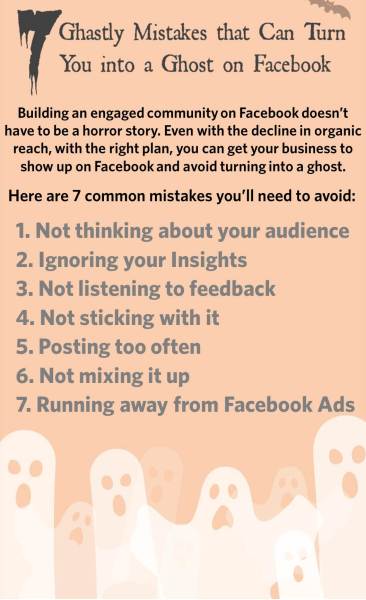
To learn more, visit our Facebook 101 page in the Social Media Quickstarter.
Before your customers know anything about you, they’ve probably seen your logo.
What do people say about first impressions?
When I had to create a logo and tagline for our Outrageous Success movement on Facebook. I did not want to rush the process for two reasons. First, I understand its importance and second, a good logo conveys a lot of information, often in a fairly abstract format.
Sometimes you need to really think deeply and give yourself enough time to understand what it is you’re communicating.
If you don’t have a logo for your business or are considering a new business, here are some points to ponder as you make your choice.
What a logo should do
Good logos say a lot about your business and they communicate on various levels. When coupled with a tagline, they can speak more directly to people. Here is what a good logo can do for you.
Establish a brand identity. This is the first thing a well-designed logo will do for you. When customers see it, they think automatically about your business.
Give your business a professional and established look. A good logo takes your business to the next level above “a person with a business card.” People should subliminally think, “This must be a real company. It has a strong logo.”
Communicate what you do. Potential customers should look at your logo — and perhaps your tagline — and see that you offer something they may need.
Build loyalty. The repeated exposure to your logo should remind customers of your exemplary customer service or top quality line of products. If you have created a positive business relationship with people, they will be reminded of that every time they see your logo.
Basic logo designs
Highly successful companies have different approaches to logo design and they fall into four basic categories. No single category is inherently superior to any other, although some may be easier to conceive.
Type based. Your logo could be a typographical treatment of your business name. Facebook and Sony would be examples of this style. The big ones are the business equivalent of single name celebrities, like Oprah.
Illustrations. Other businesses use an illustration that communicates who they are. The purest of these might be the logos of some professional sports teams, such as the St. Louis Cardinals and Denver Broncos.
Abstract. We all know the Nike swoosh. We never need to see the name of the company. Further, its design has come to communicate speed and athleticism.
Hybrids. Often type will be combined with either a realistic illustration or abstract design. The type may be the name of the company, a tagline or both.
Color me customer-centric
The colors you choose for your logo are as important as the design. Colors communicate on a very instinctive level and you have to keep this in mind as you select your design.
Far too many small business owners just go with colors they like. When you think you have a good basic color you want to use, do an online search for color schemes and you can find other colors that will go along with it.
Whether you decide to try to design your own logo, find a local designer or connect with a freelancer over the Internet, these points should help you decide the direction you need to go and help you recognize a winning design.
About the Author: Susan Solovic is THE Small Business Expert. Sign up for Susan’s Success Tips Newsletter and get your free copy of “Smart Marketing Strategies for Small Biz” ebook.
A lot of social media advice sounds something like this: start using social media, schedule your social posts ahead of time, have a consistent presence, and then you’ll find new customers!
Simple enough, right?
If you’ve given this technique a try, you might have realized it’s not always quite that easy. And as a small business owner, you have plenty of other projects vying for your attention.
The best way to build an active and engaged audience on social media is to focus on the people who already know you best. By sharing content that’s relevant to them, and taking the time to interact and respond to any feedback you receive, you’ll be able to grow the size of your audience and build stronger relationships in the process.
But when it comes to seeking out new customers on social media, there are also a few simple steps you can take to help you reach the right audience for your business.
Here are a few important steps to consider:
Step 1: Identify a target audience
Knowing your ideal customer persona is half the battle. You also need to think about the problem(s) your product or service solves. What language would a customer use to identify the problem? What is the best way to engage with this customer?
At MarketMeSuite, we help small businesses succeed on social media, so I use MarketMeSuite’s Real-time Search to find conversations on social media that include keywords like social media help, small business help, and SMB tips.
When I find people using these keywords, I can easily learn which social networks my customers are using. I can also determine the type of content they want and the best time and frequency to post. This makes me much more effective at reaching my audience on social media.
Step 2: Search for relevant #hashtags and keywords
The next step is to find and track conversations. Hashtags do some of the work for you by helping you find a number of people talking about the same topic.
Once you’ve determined your relevant hashtags, monitor them to find the conversations you should be a part of. The hashtags I follow include #smallbusiness (my target audience), #MarketMeSuite (our company name for monitoring), and #socialmediahelp (conversations where I can add my expertise).
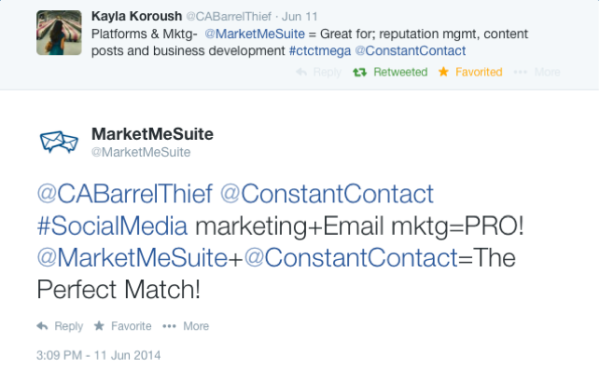
Here’s an extra tip: You can also find the influencers you should be liking and following using hashtags. Influencers are experts in topics related to your business and often have a large following. Engaging with them can help you gain exposure to a bigger, equally targeted audience.
Step 3: Engage with relevant audiences
Once you’ve found social conversations that are relevant to your business, you can start to engage potential customers and share your expertise.
Make sure to add to the conversation without disrupting it. If people are sharing and commenting on articles related to your business, look for opportunities to share your perspective. If people ask questions you can answer, offer your help.
Here’s an extra tip: If you already partner with other businesses, you can look for opportunities to engage with your shared audiences on social media. For example, one of the most complementary tools to MarketMeSuite is Constant Contact. Our companies share the same goal of helping small businesses succeed.
Step 4: Use the right calls to action
Hopefully, all your hard work of finding and connecting with potential customers on social media will pay off in the forms of new fans and followers. As you start engaging with your new audience, it’s important to provide a strong call to action to help move interactions beyond social media.
Posts that provide a call to action are more likely to get engagement (i.e. likes, follows, shares, retweets, favorites) from your audience.
Make sure your call to action isn’t always directly related to your product or service. People often use social media to be entertained, to find valuable information, and to interact with friends and businesses.
You can make your content engaging by asking your audience a fill-in-the-blank or true or false question.
As a rule, about half your content should be solely focused on engagement, with only about 20% of your content focused on the promotion of your business.
You can use this chart as a reference.
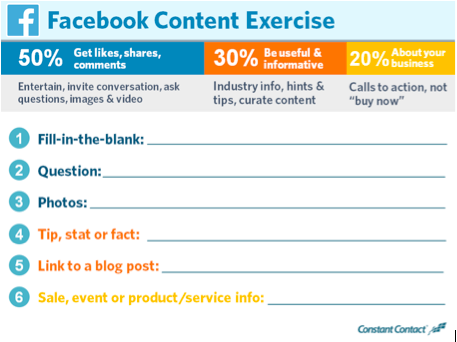
Have you been successful finding new customers on social media? How did you do it? Let’s chat! Just respond below.
About the author: Allison Davis is Community Manager at MarketMeSuite, a social media marketing and engagement platform for small businesses. She’s an expert in social media engagement and is the face behind MarketMeSuite’s social channels. MarketMeSuite was the first company to pilot Constant Contact’s Small Business Innovation Program.
October is Small Business Month in Canada!
To celebrate, we are sharing helpful resources and holding special training events to help small businesses improve their marketing, and do more business.
In honor of Small Business Month, we’ve also compiled some of our favorite success stories from small businesses in Canada.
These businesses have achieved impressive results, and have great advice for other Canadian business owners, and business owners around the world!
Here are four email marketing tips from successful small businesses:
1. Use a clear and concise design
 Business: The Avenue Gallery
Business: The Avenue Gallery
Location: Victoria, British Columbia
Results: Standing out in a crowded market; staying connected with loyal customers
When you open an email from The Avenue Gallery, you know right away what you’re receiving, and why it’s important to you.
That’s because owner, Heather Wheeler, uses a few simple best practices to make sure the gallery’s emails are easy to read and interesting to the people receiving them.
This includes, adding an instantly recognizable logo at the top of each email, using concise language and a clear call-to-action, and including eye-catching images that support the content she sends out.
According to Heather, the gallery gets calls each time an email goes out.
Key takeaway: Using a design that’s clear and concise is more important than ever in today’s increasingly mobile world. This means choosing an email template that looks great on mobile, and keeping the content of your email as focused as possible.
2. Provide a personal touch
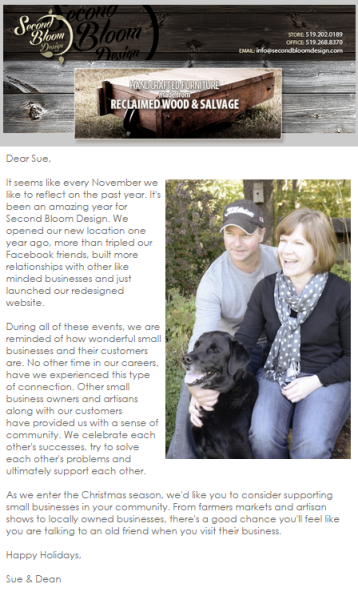
Business: Second Bloom Design
Location: Dorchester, Ontario
Results: Doubling their business in the first year; generating new orders with each email
Second Bloom Design isn’t your typical furniture store. The family-owned business uses their passion and craftsmanship to create handcrafted furniture from reclaimed wood and architectural salvage.
And while their quality of work is what keeps customers coming back, they have also added a valuable marketing tool to help them stay in touch with customers — email marketing.
“It helps us stay in our customer’s lives without overwhelming them,” explains Sue Bedell, owner of Second Bloom Design. “We decided from the start that we wanted it to be something that people would actually want to read and look forward to seeing in their inbox.”
In addition to keeping customers updated about what’s going on at the shop, Sue also includes a personal note to customers in each email she sends out.
“It’s always nice to hear someone tell us how much they enjoyed reading our newsletter and thanking us for reminding them to come visit the store or give us a call,” she explains. “The personal touch really makes the difference.”
Key takeaway: Offering a personal touch will help you stand out in the inbox, and better connect with the people receiving your emails. Look for opportunities to humanize your marketing and you’ll have more people opening, reading, and acting on your emails.
3. Add value
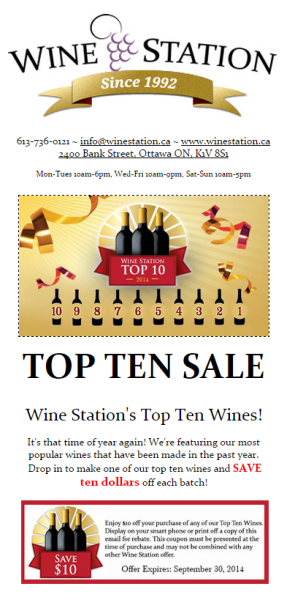
Business: Wine Station
Location: Ottawa, Ontario
Results: A single email drove 400 customers to an event that is typically only attended by about 40 customers
When people join your email list, they want to stay connected with your business. But to keep them engaged, you need to make sure you’re offering something of value.
For some people, that value can come from knowing about your latest products or services, and for others it may be receiving special offers and deals.
Wine Station, a wine shop in Ottawa, Ontario, provides both. In addition to letting customers know about seasonal and new items, they also include a special coupon for email subscribers.
This has resulted in increased foot traffic at their store, and better attendance at in-store events.
Key takeaway: Think about what your audience will find valuable. If they know your emails will offer something they’re interested in, they will be more inclined to pay attention when you show up in their inbox.
4. Be timely
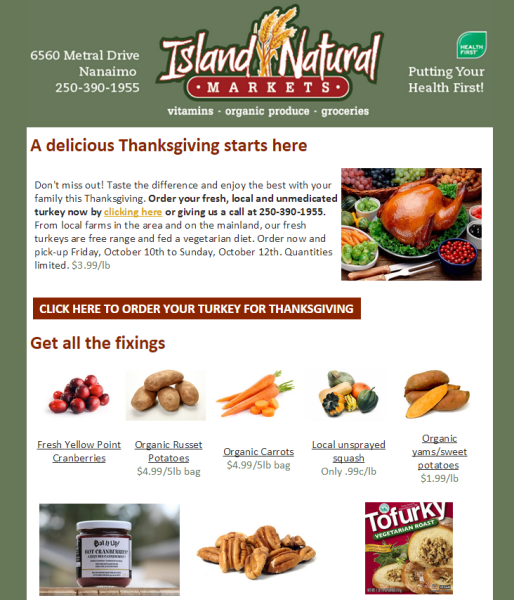
Business: Island Natural Markets
Location: Nanaimo, British Columbia
Results: Staying connected with customers; generating new business with each email
It’s important to think outside of your business when developing a plan for your email marketing.
This is something Island Natural Markets knows well.
Over the last two decades, they have grown to become the largest health food store and supplier of organic food and products in British Columbia.
One of the keys to their success has been the ability to understand what customers are interested in at different times of the year. This has certainly been true for their email marketing. They send a monthly email newsletter with information about seasonal events, recipes for different times of the year, and products that are popular that month.
Since 2011, the Island Natural Markets email newsletter has been one of their biggest drivers of new business.
Key takeaway: Your audience’s interests, needs, and expectations can change a lot from month-to-month. Focus on making your emails relevant to your audience throughout the year.
Share your expert tips!
Help us celebrate Small Business Month Canada by sharing your best email marketing tips in the comments below. You can also explore these resources specific to Canadian small business owners and skyrocket your business growth today!
Put these tips to work today! Log in now.
Looking for inspiration? Visit our email campaign ideas page.
